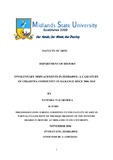Please use this identifier to cite or link to this item:
https://cris.library.msu.ac.zw//handle/11408/4032Full metadata record
| DC Field | Value | Language |
|---|---|---|
| dc.contributor.author | Tazarurwa, Tatenda | - |
| dc.date.accessioned | 2020-12-11T11:55:11Z | - |
| dc.date.available | 2020-12-11T11:55:11Z | - |
| dc.date.issued | 2016-11 | - |
| dc.identifier.uri | http://hdl.handle.net/11408/4032 | - |
| dc.description.abstract | It was in the year 2006, when diamonds were officially revealed in the Marange communal lands of Zimbabwe. In as much as people who remained behind at Chiadzwa were depressed of their farm lands, those villagers who had already been relocated also professed themselves as cursed due to a twine of misfortunes affecting their destiny.1 Ecologically, Chiadzwa lies in the aridity region. Its annual rainfall is not only low, but also unreliable. Over an extensive period of time, inhabitants tested with various coping strategies in order to pacify their harsh environment. This included the subsequent concentration on the cultivation of drought-tolerant crops. They also collected wild fruits and carried out basketry in exchange for food. Before the year 2006, Chiadzwa was hardly as critical and special economically as it became thereafter. In fact, it was a deserted area since succeeding colonial and post-colonial governments could not plan for long-term projects such as irrigation schemes similar to those established at nearby Nyanyadzi or elsewhere in the country. Economical development in the area was nominal, so were the area’s agriculture and food shortages.2 However, the detection and successive mining of sedimentary diamonds at the area of Ushonje, in Chiadzwa, brought unparalleled hope to local inhabitant that is the Chiadzwa community, particularly with regards to food security and infrastructural development. Residents looked up to the state for the development of infrastructure to rap the diamonds and direct some of the much needed proceeds to the area’s food needs. Outlooks were high that since Chiadzwa utter within the confines of two rivers, Save to the West and Odzi to the East, revenue from diamond mining would be directed into water harvesting schemes from these sources to increase agricultural productivity, rather than trusting only on rain-fed cultivation. But by the end of 2007 signs were already screening that all was not well as the state initially let illegal miners, to illegally crumple up for diamonds.3 Already, some young people could not benefit directly from this tactic as it was an issue of “survival’ of the fittest. Hence the people of Chiadzwa said that the diamonds proved to be a curse to their living. It was after the discovery of diamonds that the government introduced and employed a relocation programme. This resulted in the relocation of the Chiadzwa community preparatory from 2010 so as to pave way for the mining of diamonds by private mining companies. This dissertation contends the establishment of accommodation as positive move on the part of Government and mining companies, but the question of living in the new environment was barely attempted. Undeniably, by 2010, several families had been relocated into the newly-built housing units. At first, the affected people expressed cheerfulness that the mining companies were genuine, especially due to the apparently clad accommodation at the new site plus the promise of food aid.4 No sooner did people settle than they were already condemning the state and mining companies of defaulting on their undertaking to feed them. Most of the promises attested to be a paper tiger which hardly went beyond measly expression of romanticism as they were not transformed into practical action. The facilities at Odzi were widely doomed because they lacked alternative means of livelihood compared to those at Chiadzwa where bearable options such as fruit collection, basketry and animal rearing were readily available to foil crop cultivation. This placed the newly-resettled inhabitants in an undesirable and unwarranted position as they were challenged with a hugely bargained food and water supply situation.5 Villagers’ attempts to approach appropriate authorities for amplification failed to yield positive results as those stakeholders were not only elusive, but also supercilious and unwilling to shed light on the rapidly changing economics of relocation. | en_US |
| dc.language.iso | en | en_US |
| dc.publisher | Midlands State University | en_US |
| dc.subject | involuntary displacements | en_US |
| dc.subject | chiadzwa community | en_US |
| dc.subject | marange | en_US |
| dc.subject | 2006-2015 | en_US |
| dc.title | Involuntary displacements in Zimbabwe : a case study of Chiadzwa Community in Marange since 2006-2015 | en_US |
| dc.type | Thesis | en_US |
| item.fulltext | With Fulltext | - |
| item.openairetype | Thesis | - |
| item.openairecristype | http://purl.org/coar/resource_type/c_18cf | - |
| item.languageiso639-1 | en | - |
| item.cerifentitytype | Publications | - |
| item.grantfulltext | open | - |
| Appears in Collections: | Bachelor Of Arts In History Honours Degree | |
Files in This Item:
| File | Description | Size | Format | |
|---|---|---|---|---|
| Tatenda.pdf | Full Text | 476.04 kB | Adobe PDF |  View/Open |
Items in MSUIR are protected by copyright, with all rights reserved, unless otherwise indicated.



